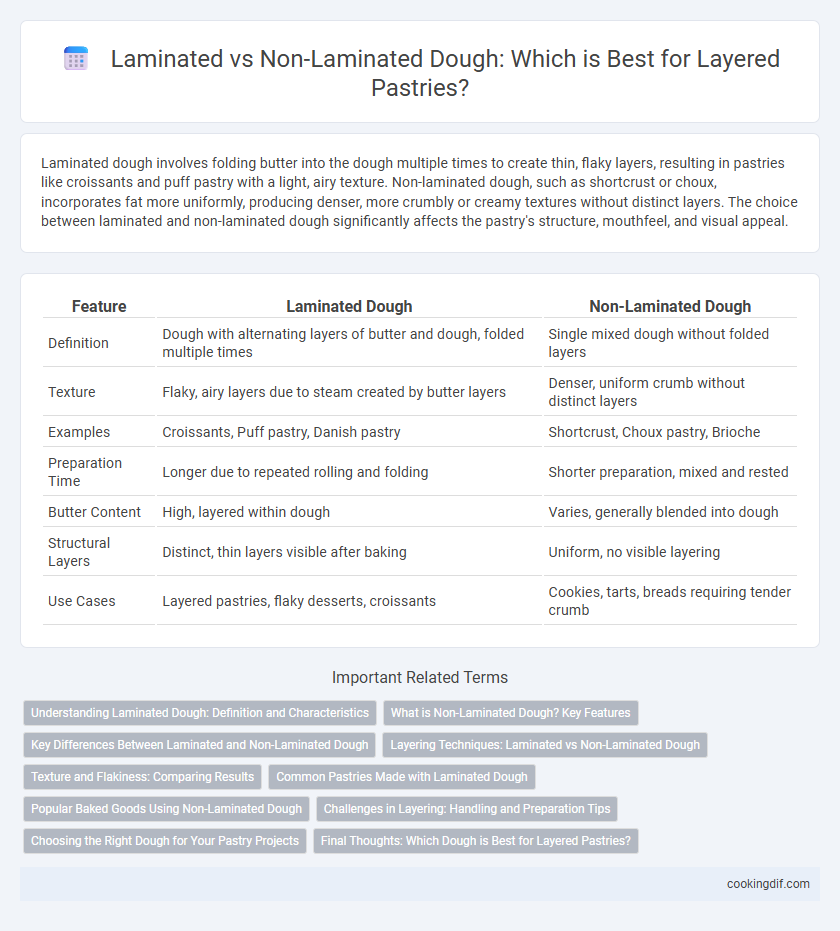Laminated dough involves folding butter into the dough multiple times to create thin, flaky layers, resulting in pastries like croissants and puff pastry with a light, airy texture. Non-laminated dough, such as shortcrust or choux, incorporates fat more uniformly, producing denser, more crumbly or creamy textures without distinct layers. The choice between laminated and non-laminated dough significantly affects the pastry's structure, mouthfeel, and visual appeal.
Table of Comparison
| Feature | Laminated Dough | Non-Laminated Dough |
|---|---|---|
| Definition | Dough with alternating layers of butter and dough, folded multiple times | Single mixed dough without folded layers |
| Texture | Flaky, airy layers due to steam created by butter layers | Denser, uniform crumb without distinct layers |
| Examples | Croissants, Puff pastry, Danish pastry | Shortcrust, Choux pastry, Brioche |
| Preparation Time | Longer due to repeated rolling and folding | Shorter preparation, mixed and rested |
| Butter Content | High, layered within dough | Varies, generally blended into dough |
| Structural Layers | Distinct, thin layers visible after baking | Uniform, no visible layering |
| Use Cases | Layered pastries, flaky desserts, croissants | Cookies, tarts, breads requiring tender crumb |
Understanding Laminated Dough: Definition and Characteristics
Laminated dough is a type of pastry dough created by repeatedly folding and rolling butter into the dough, producing distinct, thin layers that result in a flaky, airy texture when baked. This dough is commonly used in croissants, puff pastries, and Danish pastries due to its unique layering technique that traps steam for optimal rise and crispness. In contrast, non-laminated dough lacks these layers, leading to a denser and less flaky final product.
What is Non-Laminated Dough? Key Features
Non-laminated dough refers to pastry dough that is mixed and folded without creating distinct, alternating layers of dough and fat. Key features include a denser, uniform texture and a tender crumb, often used in pastries like Danish or brioche where flakiness is less pronounced compared to laminated dough. This dough relies on fermentation or leavening agents rather than mechanical layering to develop structure and flavor.
Key Differences Between Laminated and Non-Laminated Dough
Laminated dough incorporates multiple thin layers of butter folded repeatedly between dough sheets, creating a flaky texture ideal for croissants and puff pastries. Non-laminated dough blends fat uniformly into the flour, resulting in a denser, more cohesive crumb suited for breads and some cakes. The distinct layering technique in laminated dough enhances flakiness, while non-laminated dough emphasizes tenderness and moisture retention.
Layering Techniques: Laminated vs Non-Laminated Dough
Laminated dough involves multiple layers of dough and butter folded and rolled together, creating a flaky, airy texture ideal for croissants and puff pastries. Non-laminated dough uses continuous layering by incorporating ingredients like fat directly into the dough or using folding techniques without distinct butter layers, resulting in a denser, chewier crumb common in Danish and brioche pastries. Mastering laminated dough layering requires precise temperature control and rolling, while non-laminated methods focus on gluten development and fat distribution for optimal texture.
Texture and Flakiness: Comparing Results
Laminated dough, such as puff pastry, creates distinct, thin layers by folding butter between dough, resulting in a light, flaky texture with crisp, airy layers. Non-laminated dough lacks these multiple butter layers and produces a more uniform, denser crumb with softer texture and less flakiness. The key difference lies in the lamination process, which traps steam and separates layers, maximizing flakiness and a delicate bite in laminated pastries.
Common Pastries Made with Laminated Dough
Common pastries made with laminated dough include croissants, Danish pastries, and puff pastry treats, all characterized by their distinct, flaky layers created through repeated folding and rolling of dough and butter. This technique results in a light, airy texture with a crispy exterior, unlike non-laminated doughs such as pie crusts or brioche, which have a denser crumb and lack layered flakiness. Laminated dough's unique layering process is key to achieving the signature rise and delicate mouthfeel found in these classic baked goods.
Popular Baked Goods Using Non-Laminated Dough
Non-laminated dough, characterized by its single layer of dough without alternating butter layers, is commonly used in popular baked goods such as brioche, challah, and quick breads. These pastries rely on yeast or chemical leaveners for rise and texture rather than the flaky, layered structure of laminated doughs like croissants and puff pastry. Non-laminated dough produces tender, soft crumb textures ideal for enriched breads and simple pastries.
Challenges in Layering: Handling and Preparation Tips
Laminated dough challenges include maintaining precise temperature control to prevent butter melting and ensuring even rolling to create distinct, flaky layers, while non-laminated dough requires careful moisture balance to avoid soggy or dense textures. Handling laminated dough demands frequent chilling and gentle manipulation to preserve the alternating fat and dough strata essential for puffiness. Preparation tips emphasize using cold ingredients, using minimal flour for rolling, and resting the dough adequately to facilitate proper gluten development and layer separation.
Choosing the Right Dough for Your Pastry Projects
Laminated dough, such as puff pastry and croissant dough, is characterized by multiple thin layers of butter and dough that create a flaky texture through steam during baking. Non-laminated dough, like pie crust or tart dough, achieves tenderness and structure without distinct layers, relying on fat distribution for a crumbly or tender bite. Selecting laminated dough suits pastries requiring crisp, airy layers, while non-laminated dough is ideal for dense, buttery bases in pies and tarts.
Final Thoughts: Which Dough is Best for Layered Pastries?
Laminated dough creates distinct, flaky layers by incorporating butter through folding and rolling, ideal for croissants and puff pastries. Non-laminated doughs, such as shortcrust or choux, produce denser layers with a tender crumb, suitable for tarts and eclairs. For achieving optimal flakiness and airy texture in layered pastries, laminated dough remains the superior choice due to its buttery, crisp, and well-defined layers.
Laminated dough vs Non-laminated dough for layering Infographic

 cookingdif.com
cookingdif.com